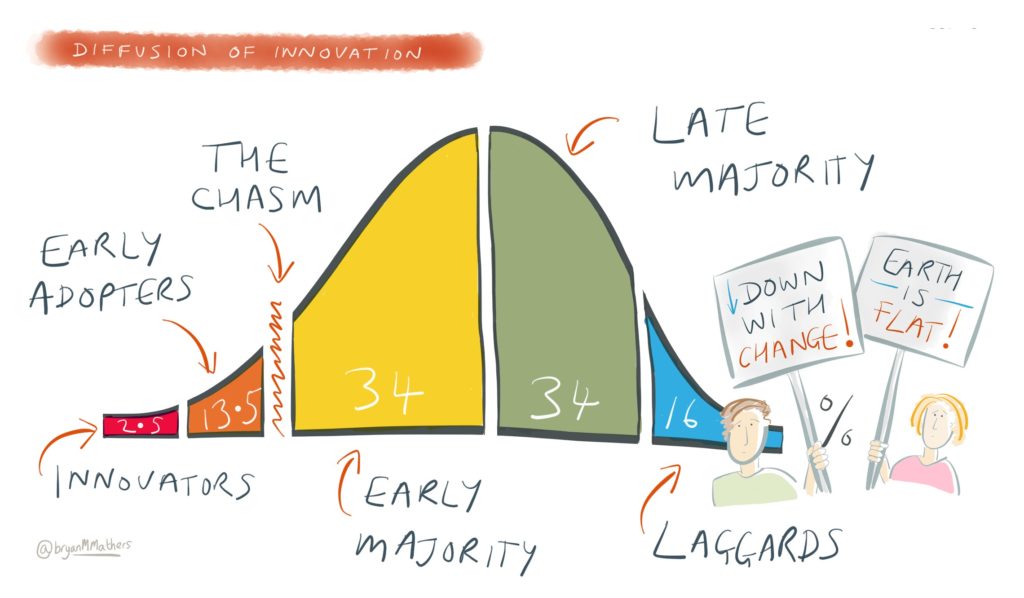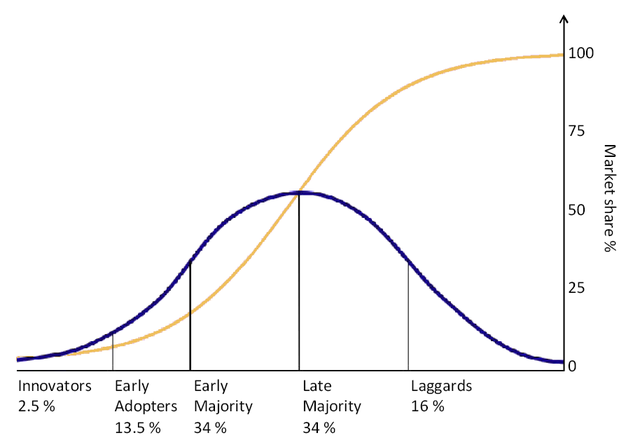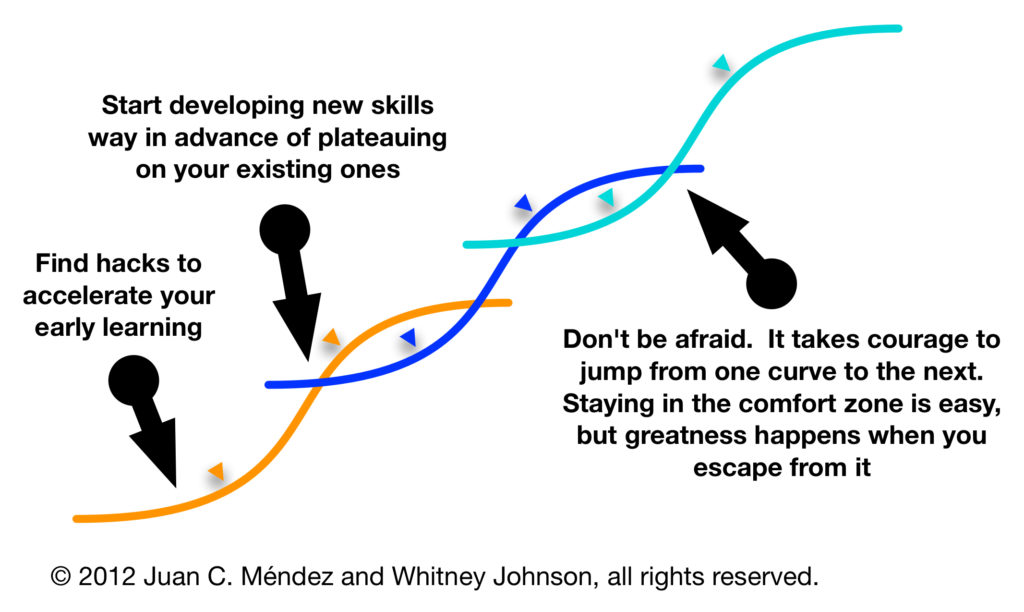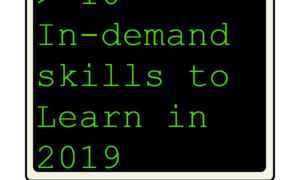In the technology
In my experience what separates those who love their career and those who get burned out is how well that person learns to ride the technology waves. (or curves to keep with this posts theme)
What sparked this article
While I was at Kubecon in Seattle, one of the presenters had a slide with Everett Roger’s “Diffusion of Innovation Adoption Curve”. They were using it to explain how Kubernetes was getting closer to “crossing the chasm”.
The chasm is the point at which a given technology goes makes the jump from science project to a commercialized product that is ready for the majority of people to start using.
If you aren’t familiar with “Diffusion of Innovation” or “chasm”. Here is a picture.

You have probably been an innovator or an early adopter. Likewise, you have also been part of the majority, and in some cases, probably even a laggard.
Here is a great video to get you up to speed on this theory. It’s only three minutes long and worth watching.
Sooner or later there is saturation
How many people do you know that have a computer? Probably almost everyone. We can safely say that only a few laggards don’t have some type of computer at this point. The market is saturated.

We can overlay a saturation curve (a.k.a. market share %) on top of the innovation curve. Now the question is, how does a company continue to grow revenue once a market is saturated?
The answer, sometimes, is to create a new product. Take Apple
How this is career related
All products have careers associated with them. Products need developers, sales, marketing, support, etc.
As some products reach the end of their lifecycle (due to new technology innovations, or market saturation) resources generally get shifted to focus on newer or more profitable products.
Why all of these curves have to do with your career is simple.
The earlier you make the “jump” from a curve which has reached “Late Majority” or “Laggard” stage to a new curve which is either in the “Innovators” or “Early Adopters” stage, the more prepared you will be once that technology “Crosses the Chasm.”
Let me be clear – I’m not suggesting you quit your current job. What I am suggesting is that every time you get comfortable in your current role, start learning something new about a different technology.
If you are looking for new ideas check out my 10 In-demand skills to learn in 2019 post here.
Let’s use another picture. In the graph below assume your current job is the orange curve.

As soon as you are getting really awesome at your job, and the line starts to shoot upwards, you should start learning new skills. You know you’re ready for those new skills because your current job will become “easy” or mundane. (Which could lead to burnout)
You can rinse and repeat this method over and over… pretty much until you die or become a millionaire.
You should also consider that as more and more people adopt a technology, and more people learn how to use that technology your skills (in that technology) become a commodity (ie
My curvy career path
I’ve been in the I.T. industry officially since 2003. I started out as a help desk technician. I like to think I was WAY overqualified, to say the least, I was bored to death. I looked for ways to do things faster and better, but no good deed went unpunished.
I already knew Linux pretty well, I knew Windows really well, I knew the basics of networking and plenty of other technologies. You could say that I had already done the learning part of several other tech curves. Which made the transition to a reseller an obvious choice.
My second role put many more of my skills to use. I joined a small VAR and spent several years working on all sorts of things. Eventually, I needed a bigger challenge. I wanted to work on bigger things like blade chassis, fiber channel storage arrays, 10Gbps network, etc. The solution wasn’t a new curve… just a bigger version of the one I was already on. I moved to a new VAR that had larger customers and bigger toys for my to play with.
There were some transitions at the larger VAR and eventually, they were acquired. I was never
I did several rounds of interviews with Veeam. However, Sean Masters was dumb enough to offer me a job at Zerto which I was super excited to take.
I was looking for a career change that wasn’t dependent on
I’m already starting my 4th year at Zerto, I did get bored with my original role (Sales Engineer) and switched to a new role (Technical Alliances), and now I find each week a challenge where I get to learn new technologies as well as contribute ideas. No boredom in sight!
Who knows what the future holds, but I know both Azure and AWS very well. I have experience with containers, JSON, REST APIs, and some pretty advanced scripting (zPlanner), among
OK, I’m going to call you out!
I get to go to a bunch of conferences and meet a lot of people from different fields. (Developers, Marketing, Sales, Customers, etc) It’s a perk of working in an alliances role. So I want to share the biggest thing I’ve learned in 2018.
New technologies are “growing up” and getting ready to transition to early majority adoption. (ie containers, public cloud, IoT, and more)
Side note… 2019 will still not be the year of VDI…Sorry VDI nerds.
While others, are entering the late majority or even into the laggard stage. (ie virtualization)
Before you get upset because I’m talking crap about virtualization, remember that just because it’s getting late into the adoption curve and saturation curve, that doesn’t mean it is going away. It just means that people with those skills will also become more of a commodity.
How sexy was it to be a CCNA circa 2001? How sexy is it now? If you want the sexy network related role, you’re talking SDN,
My
The key takeaway is to get prepared for whatever the next big thing is. If you are prepared, you control when and if you make the jump to a new curve.
A great place to learn about exciting new technology is by checking out the Tech Field Day events.
Are you making a jump to a new curve? Leave a comment and tell us how you did it!
One last fun fact. VMware was delivering the presentation with the tech adoption curve. They were the ones explaining how Kubernetes was almost ready for the majority of adopters…
References
Here are some of the links I read while doing research for this post:
Future proof your career – S-Curve Yourself
Harvard Business Review – Throw Your Life a Curve
Digital Media Distribution Acceleration (shows how different technologies have different length of curves)
![]()



Pingback: Why Innovation, Risk, and Curves make for the best careers - Tech Field Day